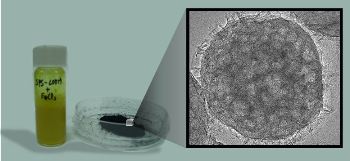Jul 9 2013
Researchers from Ulsan National Institute of Science and Technology (UNIST) developed a new method to massively synthesize enhanced yet affordable materials for supercapacitors.
 3D Mesoporous Graphene
3D Mesoporous Graphene
Supercapacitors have attracted increasing attention due to their long life cycle, highly reversible charge storage process and specific power density along with increased concern over the exhaustion of natural resources.
Graphene has been recognized as a promising active material for supercapacitors due to its outstanding electrical conductivity and large surface area, as they are the two most important requirements for supercapacitors.
Among the various methods for the fabrication of graphene sheets, the chemical vapor deposition (CVD) technique is highly recommended due to the high conductivity of as-prepared graphene. But the scalability is still needed for commercialization. Additionally these limitations called for great interest on further improvement.
The research team led by Prof. Ji-Hyun Jang from UNIST, previously reported a novel approach to synthesize chemical vapor deposition-grown three-dimensional graphene nano-networks (3-D GNs) that can be mass produced while retaining the excellent properties of 2D graphene and published in the (Nature Publishing Group) Scientific Reports in May 2013.
Here, Prof. Jang extended her previous research in Scientific Reports and demonstrated a unique route to obtain a mass-producible mesoporous graphene nano-ball (MGB) with a large surface area and great conductivity, via precursor-assisted CVD, using metal precursors as a catalyst which is applicable to supercapacitors.
Prof. Ji-Hyun Jang is from the Interdisciplinary School of Green Energy at UNIST and the fellow researchers include Jung-Soo Lee, Sun-I Kim and Jong-Chul Yoon from the Interdisciplinary School of Green Energy at UNIST.
Compared to the conventional graphene synthesis methods, a new way, suggested by the UNIST research group, is scalable and able to produce high quality and customizable graphene with better environmental impacts.
With the resulting materials, mesoporous graphene balls, the capacity of supercapacitor has been improved significantly. Due to the unique mesoporous structure, three-dimensional networks are formed, which help to improve conductivity. Furthermore, mesopores inside the graphene surfaces induce nanochannels to transport ions in electrolyte, and improve the properties of supercapacitor.
The MGB presents a specific surface area of 508 m2/g and mesoporosity with a mean pore diameter of 4.27 nm. The conductivity of the p-doped MGB obtained from more than 10 samples was 6.5 S/cm. The MGB-based supercapacitor shows good performance, including an excellent capacitance of 206 F/g and 96% retention of capacitance after 10,000 cycles even at a high current density.
“Our work is very meaningful since we succeed in the fabrication of CVD-grown graphene with high qualities on a gram scale,” said Prof. Jang. “When the mesoporous graphene balls are used as an electrode material for supercapacitor, it proves great potential for energy storage devices with high efficiency.”
She also said “If the properties of mesoporous graphene are improved further by continuous research, developing an electric vehicle with high power will become a realization not just a dream,” showing their future research plan.
This research was supported by National Research Foundation (NRF) and the local science park by the Ulsan metropolitan city. It was published in ACS nano (Title: Chemical vapor deposition of mesoporous graphene nano-balls for supercapacitor ).
The original research article is available at http://pubs.acs.org/doi/abs/10.1021/nn401850z